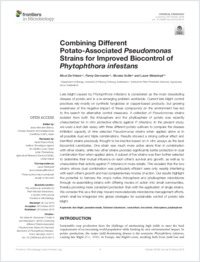Combining different potato-associated pseudomonas strains for improved biocontrol of Phytophthora infestans
- Vrieze, Mout De Department of Biology, University of Fribourg, Switzerland - Institute for Plant Production Sciences, Agroscope, Nyon, Switzerland
- Germanier, Fanny Department of Biology, University of Fribourg, Switzerland
- Vuille, Nicolas Institute for Plant Production Sciences, Agroscope, Nyon, Switzerland
- Weisskopf, Laure Department of Biology, University of Fribourg, Switzerland
- 29.10.2018
Published in:
- Frontiers in Microbiology. - 2018, vol. 9, p. 2573
English
Late blight caused by Phytophthora infestans is considered as the most devastating disease of potato and is a re-emerging problem worldwide. Current late blight control practices rely mostly on synthetic fungicides or copper-based products, but growing awareness of the negative impact of these compounds on the environment has led to the search for alternative control measures. A collection of Pseudomonas strains isolated from both the rhizosphere and the phyllosphere of potato was recently characterized for in vitro protective effects against P. infestans. In the present study, we used a leaf disc assay with three different potato cultivars to compare the disease inhibition capacity of nine selected Pseudomonas strains when applied alone or in all possible dual and triple combinations. Results showed a strong cultivar effect and identified strains previously thought to be inactive based on in vitro assays as the best biocontrol candidates. One strain was much more active alone than in combination with other strains, while two other strains provided significantly better protection in dual combination than when applied alone. A subset of five strains was then further selected to determine their mutual influence on each other’s survival and growth, as well as to characterize their activity against P. infestans in more details. This revealed that the two strains whose dual combination was particularly efficient were only weakly interfering with each other’s growth and had complementary modes of action. Our results highlight the potential to harness the crop’s native rhizosphere and phyllosphere microbiome through re-assembling strains with differing modes of action into small communities, thereby providing more consistent protection than with the application of single strains. We consider this as a first step towards more elaborate microbiome management efforts, which shall be integrated into global strategies for sustainable control of potato late blight.
- Faculty
- Faculté des sciences et de médecine
- Department
- Département de Biologie
- Language
-
- English
- Classification
- Biological sciences
- License
-
License undefined
- Identifiers
-
- RERO DOC 323324
- DOI 10.3389/fmicb.2018.02573
- Persistent URL
- https://folia.unifr.ch/unifr/documents/307221
Other files
Statistics
Document views: 153
File downloads:
- pdf: 272
- Supplementary material: 138

